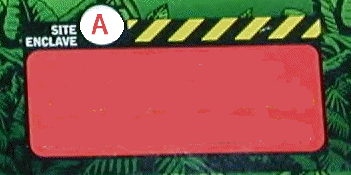
Late Triassic Norian
The Empire of the Prosauropods
From
The Dinosaur Collector;
 |
Late Triassic Norian The Empire of the Prosauropods From The Dinosaur Collector; |
216.5 to 203.6 million years ago, the second of the three parts of the Late Triassic. Earlier types of aetosaurs and phytosaurs die out, while new phytosaurs, aetosaurs, and dinosaurs appear. There is a transition from the Carnian fauna to a prosauropod dominated fauna by the end of the Norian. The climate is dryer and plants are growing higher. Conifers continue to spread. This may have favored prosauropods like Plateosaurus over low slung feeders like Placerias.
Triassic Diorama pages More Diorama
The start of the prosauropod empire. Prosauropods show up in the fossil record as fairly large animals in the Carian and are supposed to have evolved from smaller animals. From Late Norian through yje early, they dominate most terrestrial environments . Normally a single very common animal defines the enviroment: Plateosaurus in Europe / Central and North Laurasia, Euskelosaurus in southern Africa / South Gondwana, and Riojasaurus in Argentina / South-West Gondwana. The are the most common large animals for 50 million years. They are best known as the only family besides the stegosaurs to become extinct before the end of the Mesozoic. They don't get much attention and superfically look pretty much the same.
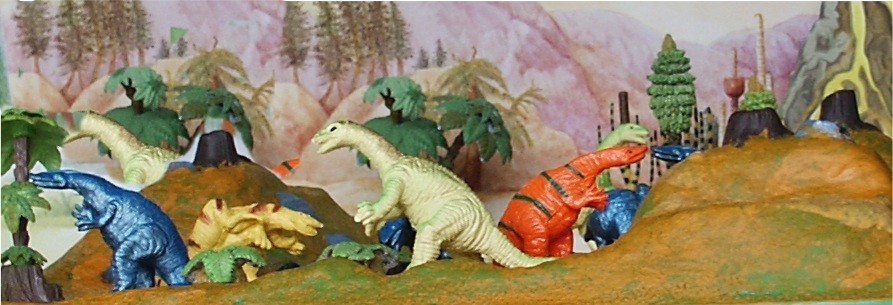
A selection of Rinco dinosaurs that have a prosauropod look. The blue are from gum ball machines the striped figures are sold in bagged sets. The green figures are from Wai made in China.
In Europe there is the Plateosaurus and turtle fauna. Proganochelys the early turtle, plateosaurs and medium-sized aetosaurs; these three plant eaters each graze at different levels, so they don't compete. The Norian age turtles which seem to emerged and really haven't changed that much since. Two species are known. Proganochelys the more common representative of the most primitive lineage of turtles It is 3 feet max is size. The broad domed shell differs from that of later turtles only in the presence of small marginal spiky plates that projected outwards, and the openings being too small to withdraw the neck and legs into. Instead, the limbs were protected by the spiked plates, and the neck by spiny scales.
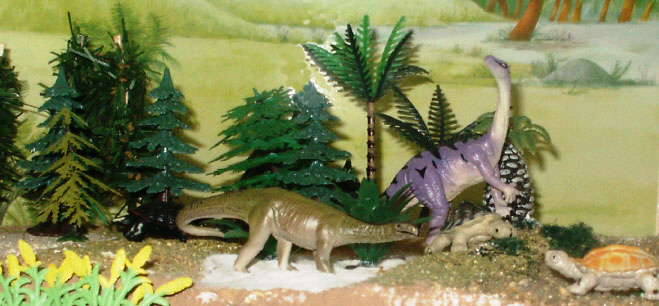
Bullyland Plateosaurus from the Standard series.
Prosauropods were once seen as the ancestors of the giant sauropods of the Late Jurassic but recent finds of sauropods in Thailand and South Africa show sauropods present in the Late Triassic. The finds are scrappy and rare but they seem to indicate large animals with bony nodules for armor. The larger Prosauropods were commonly bipedal the but the newly hatched ran around on four feet moving to two as they developed.
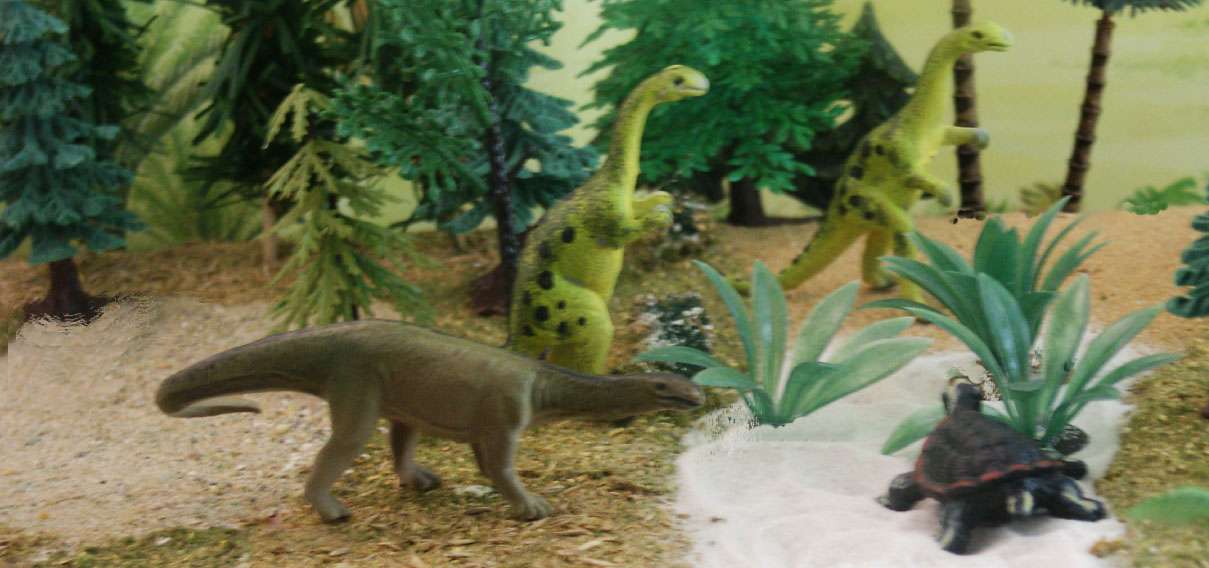
Bullyland Plateosaurus from the Standard series. Two different Marx figures custom painted by Fred Hinojosa. Notice the slight difference in the forelegs reprensent diiferent mold groups.
Thecodont carnivores remain the main terrestrial terrestrial predators through till the end of the Triassic. Teratosaurus a rauisuchiancan be compared to Postosuchus. The top predators of these early prosauropod zones are holdovers from the mid-Triassic - ornithosuchid and rauisuchid thecodonts. The jaws of Teratosaurus were found with sauropodomorph bones It was thought that these belonged to the same animal, and it was reconstructed as an early theropod. It is now known to be a rauisuchian perhaps a Poposaurid. Despite the appearance of large podokesaurian-grade theropod dinosaurs, these animals continued to serve as the dominant predator in terrestrial ecologies. Unlike the theropods, they were not fast runners, and probably ambushed their prey with a sudden rush.
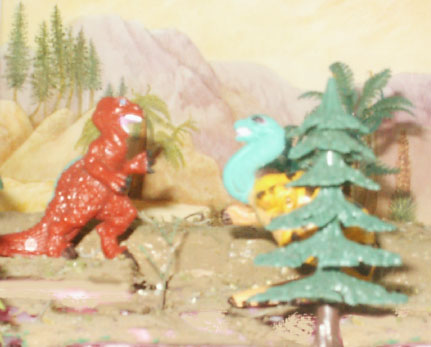
Monsters in My Pocket Teratosaurus and Plateosaurus custom painted. Primaily sold in Europe a camp tribute to the Marx figures.
Postosuchus continues into the early or middle Norian. One of the unusual and interesting rauisuchians discovered in recent times is Postosuchus, from the Triassic Dockum Formation of Texas and made famous in Walking with Dinosaurs. Postosuchus was 18 feet long and 6 feet tall. While the ornithisuchids and rauschids continued to share the top predator slot with dinosaurs, dinosaurs take over the small to medium carnivore roles and prosaurapods take over the herbivore category.
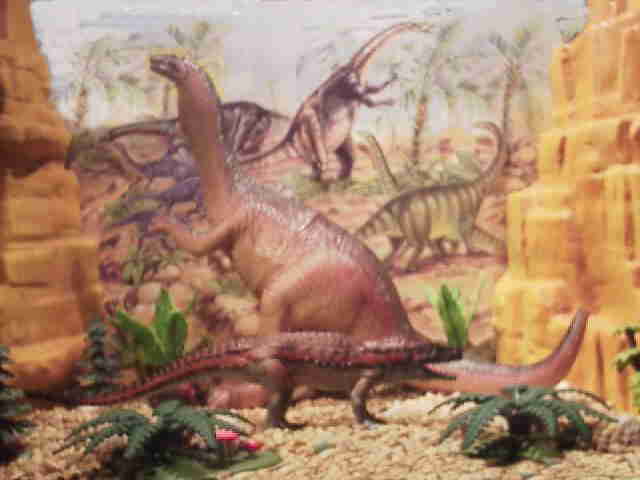
The Postosuchus is from the English Toyway line based on the Walking with Dinosaurs Documentary. The high quality toys were never sold widely in the US. Currently out of production. The Plateosaurus is distributed by Jasman. Jasman and several other toy companies distributed a series of large vinyl figures. The figures may be from several different producers. They appear to represent several different manufacturing processes and vary widely in quality. Plateosaurus is one of the better examples. Most appear have been cast in sections and joined like Plateosaurus, while others appear to be the result single piece of injection molding. All are stamped with Made and in China and the animal name. They remain popular as sand box style figures.
Medium-sized ornithosuchids, are represented in the Late Norian and Rhaetian of Argentina. Ornithosuchus (bird crocodile) was 14 feet long and once considered an early dinosaur, now as an advanced archosaur closely related to the dinosaurs. It could walk upright but probably usually moved on all fours. Its hips, toes and back armor were primitive, but the skull quite advanced. Coelophysids were once conidered to be only represented by a few species but finds of animals like Camposaurus, Eucoelophysis and Procompsognathus show many different memebers of the family lived in the same places at about the same time.
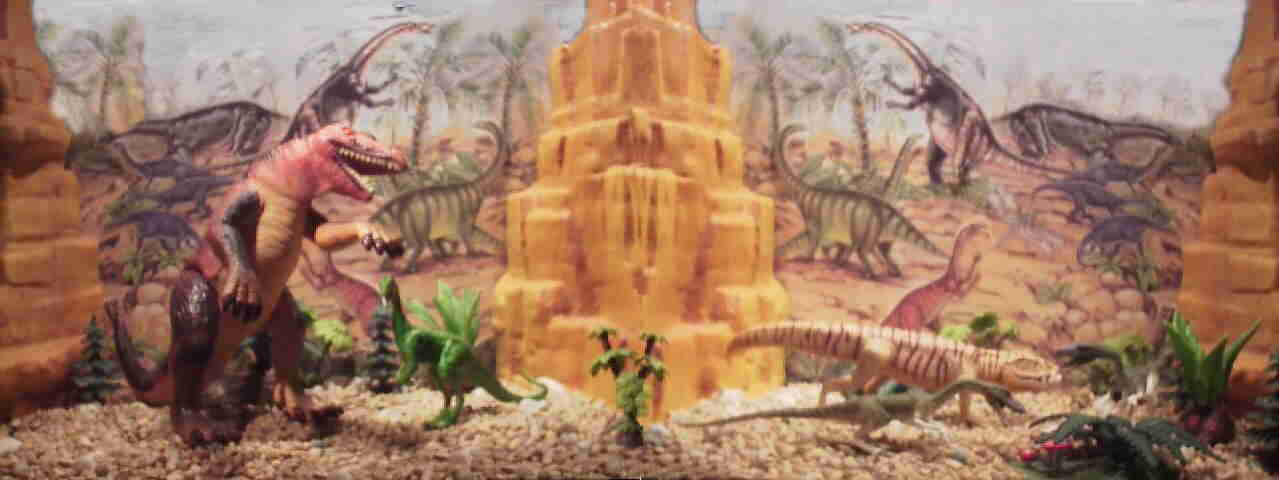
Ornithosuchus from the Thunder Beast by Sky Kids and the Play Vision Coelophysis from their American National History Museum line. Jurassic Park spawned an outstanding line of articulated figures produced by Hasbro. The Ornithosuchus is the WalMart version and the two Coelophysis are poseable.
While the ornithisuchids and rauschids continued to share the top predator slot with dinosaurs, dinosaurs take over the small to medium carnivore roles as prosaurapods take over the herbivore category. Liliensternus is bigger tan Coelophysis and smaller than the Early Jurassic Dilophosaurus . It represents a type that seems to have persisted with little change from the Middle Norian and gave rise to the large dinosaurian carnivores of the Jurassic. They were also the first of the great dinosaurian carnivores.Liliensternus probably stalked and followed plateosaur herds, waiting for an opportunity to take on, the young, the old, or the sick or injured . This is different from the llie-in-wait rauisuchian predators like Teratosaurus and Postosuchus. These large coelophysids also seem to have been rather less common than the thecodont (pseudosuchian) carnivores, which remain the main terrestrial terrestrial predators through till the end of the Triassic.
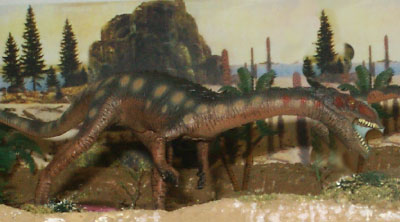
Bullyland Liliensternus.
| The palgiosaur Gerrothorax was about 3 feet long and lived in Sweden. It lived permanently in the water laying flat in streams and lake beds. This family repalced the older metoposaurs in Europe. | From scotland Saltoposuchus (Leaping Crocodile) at about 3 - 4 feet, a small, long-tailed, bipedal animal that for a long time was thought by some to have been close to the ancestry of the dinosaurs. This idea was prompted by the fact that Saltoposuchus and a few related contemporaries were among the first animals to achieve bipedal stance and gait -- that is, to be able to stand and move on two legs. Bipedal locomotion was first really perfected in some of the early dinosaurs; hence the presumed connection with Saltoposuchus. New studies, however, indicate that this animal may belong to a group of primitive crocodilians. | |
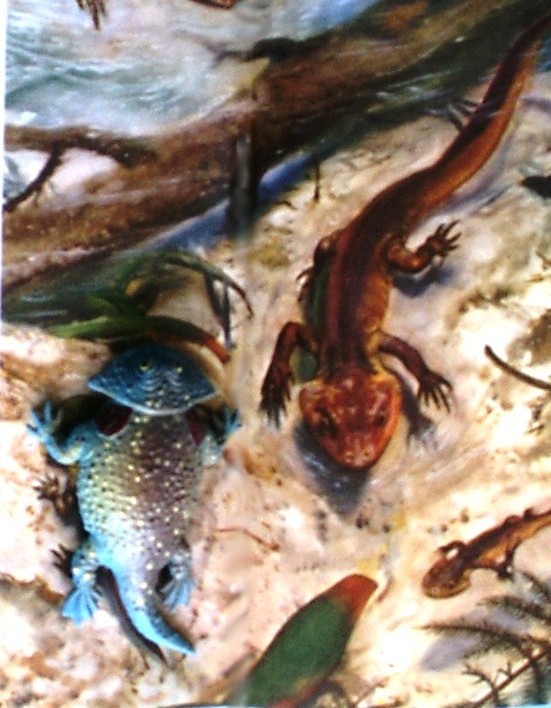 |
||
| PlayVision Gerrothorax from the prehistoric amphibian series. A brief but excellent series that has become much sought after. | Starlux Saltoposuchus |
Next more Norian
|
 Site A
icon to the right for Dioramas organized by period or by manufacturer.
Site A
icon to the right for Dioramas organized by period or by manufacturer.